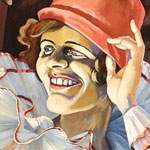
 (September 1, 1898 - April 7, 1936)
(September 1, 1898 - April 7, 1936)
The popularity of the name "Marilyn" soared exponentially in the United States over the course of Marilyn Miller's career: there were fewer than a dozen Marilyns in 1900, and in the 1930s it was the sixteenth-most-common girl's name; soon thereafter, Marilyn Monroe took her name as well. 1 Such a remarkable detail is representative of Miller's widespread acclaim as the darling of the Ziegfeld Follies and one of the most popular Broadway stars of her time.
At age six, Marilyn Miller, born Mary Ellen Reynolds, began ten years of touring America and Europe with her family's vaudeville act, the "Five Columbians." 2 Her debut as "Mademoiselle Sugarlump," at age four, was in Dayton, Ohio. 3 Miller was sixteen and already a seasoned show biz veteran when she was discovered by Lee Shubert and quickly arrived on Broadway. Dancing daintily in toe shoes or tapping up a storm, she won hearts in Shubert revues. After 209 performances at the Winter Garden in New York, she began a cross country tour with The Show of Wonders in 1917. Eventually, she caught the eye of Florenz Ziegfeld, who made her a star in the Ziegfeld Follies of 1918; in this show, she shared billing with fellow Valentine Theatre performers Will Rogers and W. C. Fields and performed an impersonation of yet another Valentine guest, Billie Burke.
A so-so singer adept at both ballet and tap, Miller's enchanting dancing persona made her Broadway's top female musical star of the 1920s. Her one biographer, Warren Harris, wrote that "She had rivals who may have been better dancers, singers, actresses, or mimics, but no one individual could equal her when it came to combining all those talents." Soon after headlining in the 1919 Follies, Miller began her longest running success, Ziegfeld's hit show Sally (1920), the story of a poor dishwasher who rises to fame as a ballerina. Ziegfeld commissioned a Jerome Kern score (including Miller's most famous number, "Look for the Silver Lining"), throwing in a Victor Herbert ballet for good measure. 4 Follies veteran Leon Errol handled the comedy, but the triumph was Miller's. By the time of her success in the Kern / Hammerstein box-office smash Sunny, Miller became the highest paid star on Broadway and the first female musical performer to receive ten percent of her shows' weekly gross, which averaged out to be between $3600 and $4000 a week. 5
On screen, Miller appeared in early sound versions of Sally (1929) and Sunny (1930), as well as Her Majesty Love (1932). Although technically primitive, surviving prints give us some sense of her charm, which cannot entirely mask her limited vocal and acting ability. Miller was acclaimed as a first-rate comedienne when she returned to Broadway in the Irving Berlin / Moss Hart revue As Thousands Cheer (1933). A series of crippling sinus and jaw infections, as well as increasing alcoholism, soon forced her to retire from the stage and led to her death in 1936. Although her Broadway career included just a dozen Broadway shows, Marilyn Miller became one of the most beloved stage stars of her time.
1. Wikipedia.
2. Harris, Warren
3. Wikipedia
4. Harris 27
5. Harris 57
Resources
Broadway, The American Musical. Public Broadcasting System. DVD. 2004.
Film footage of Miller appears briefly in this PBS documentary.
Harris, Warren. The Other Marilyn. New York: Arbor House, 1985.
This 300-page book provides excellent details about Miller's personal and public life.
Who's Who in the Theatre. London: Gale Research, 1912-1966.
A great source of information on when and where actors performed some of their most famous roles in theatres and film in America and England.
Young, William. Famous Actors and Actresses on the American Stage. New York: R.R. Bowker Company, 1975.
Good information about some of the more well-known character actors of early American stage and screen.
Stage Musicals 1920's I: Early Hits: Sally. 2007. http://www.musicals101.com.
This site had good information about Marilyn Miller and the hit musical that she starred in.